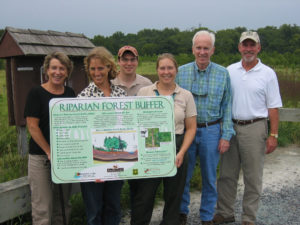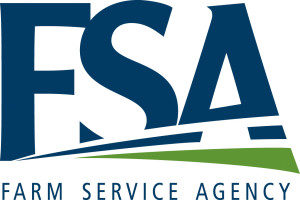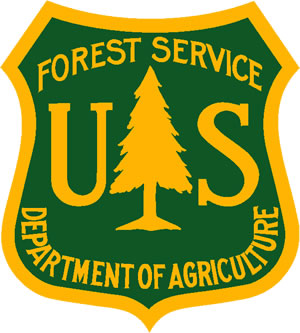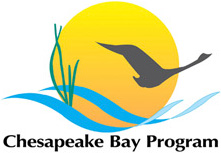Working With Partners

A successful and sustainable buffer program requires consistent funding and financing sources, readily available technical assistance, and a strong communications and outreach strategy
Few organizations have the capacity to meet all of these expectations. That is why the most successful buffer programs pool resources and support from various partners, including federal, state, and local agencies, non-profit organizations, volunteers, and the general public. The following is a primer on the groups engaged on riparian forest buffers in the Chesapeake Bay watershed and their roles.
Find your partners here.
Federal Agencies
 |
USDA Farm Service Agency (FSA) An agency of the Department of Agriculture, FSA serves farmers, ranchers, and agricultural producers through the delivery of agricultural programs. FSA’s Conservation Reserve Program (CRP) is a voluntary program for agricultural producers to plant trees or grasses to improve water quality, control soil erosion, and enhance wildlife habitat. The Conservation Reserve Enhancement Program (CREP) is a derivative program of CRP to target high-priority conservation issues identified by government and non-government organizations. In the Chesapeake Bay watershed, this includes riparian forest buffers (RFBs) for improving water quality. Farmers, ranchers, and landowners in CREP are paid an annual rental payment for land taken out of production and also receive financial and technical assistance for planting and maintaining a riparian forest buffer enrolled under the CP22 practice. Most counties in the Chesapeake Bay watershed has an associated USDA Service Center that houses agents from FSA, Natural Resources Conservation Service, and the state land grant university extension. |
 |
USDA Natural Resources Conservation Service (NRCS) An agency of the Department of Agriculture, NRCS serves farmers, ranchers and agricultural producers providing both technical and financial assistance programs to address natural resource concerns on their land. A NRCS agent may aid a landowner with developing a conservation plan, practice design, and follow up on installed practices. NRCS manages multiple voluntary cost-share programs for agricultural producers. In addition to direct financial and technical assistance to agricultural producers through its programs, the NRCS manages competitive grants for state and local governments, non-government organizations, and individuals. These include the Conservation Innovation Grant (CIG) and the Regional Conservation Partnership Program (RCPP). Both grant programs have been utilized in the past for projects to accelerate the adoption of riparian forest buffers in the Chesapeake Bay watershed. |
 |
USDA Forest Service (USFS). Primarily known as the agency managing the National Forest System, the FS also has a State and Private Forestry Program that reaches across all land ownerships and involves state and other partners to conduct priority forestry work. State and Private Forestry helps develop plans, projects, and programs for and in partnership with states, private landowners, and others to sustain the health, diversity, and productivity forests. Since 2001, the FS State and Private Forestry program has been active in the Chesapeake Bay Program, finding ways that forestry can help reach a restored Bay. The FS coordinates a Forestry Workgroup that helps with communications and decision-making around forest policy. The FS, with the help of other partners, has been leading the effort of the Riparian Forest Buffer Initiative. |
 |
Chesapeake Bay Program (CBP) is a regional partnership that leads and directs Chesapeake Bay restoration and protection. Partners include federal and state agencies, local governments, non-government organizations and academic institutions. Current restoration efforts in the Watershed are being guided by the 2014 Chesapeake Bay Watershed Agreement. One proposed Outcome of the Agreement is to plant 900 miles of forest buffers each year across the Watershed. Among other responsibilities, the CBP Forestry Workgroup supports the states in meeting the Riparian Forest Buffer Outcome of the Agreement. The CBP Forestry Workgroup is composed of a diverse group of partners that coordinates, develops and implements plans and projects that focus on restoring forests to protect the health and productivity of the Chesapeake Bay watershed. |
State Agencies
|
Departments of Agriculture promote agriculture in their respective states and works with farmers and soil conservation districts to plan and implement conservation practices. Agriculture is a major economic driver in the Chesapeake region. At the same time, the watershed is looking to the agriculture sector to provide three-quarters of the total nutrient reductions expected of Bay states by 2025. Delaware Department of Agriculture Maryland Department of Agriculture’s Office of Resource Conservation New York Department of Agriculture and Markets Pennsylvania Department of Agriculture |
|
Departments of Forestry Each state has an agency responsible for restoring, managing, and protecting their state’s forests to sustain its natural resources. This role includes supporting private forest landowners through technical assistance to manage sustainable forests. Service foresters can be found at the local level, often servicing a county or city. The service forester can assist landowners in developing a forest stewardship plan, a planting plan, and follow-up on implemented practices. State forestry departments often work with federal partners like USFS, NRCS and FSA to deliver best management practices on rural lands, including riparian forest buffers. District Department of Transportation Urban Forestry Maryland Department of Natural Resources, Forest Service New York State Department of Conservation Pennsylvania Department of Conservation and Natural Resources, Bureau of Forestry |
|
Departments of Environmental Quality, Protection, and/or Control The Departments of Environment usually have a primary role in enforcing environmental policies and regulations. In 2010, the Chesapeake Total Maximum Daily Load, or TMDL, started being enforced. A TMDL is a regulatory term in the U.S. Clean Water Act, describing a value of the maximum amount of a pollutant that a body of water can receive while still meeting water quality standards. The practices necessary to meet the Chesapeake TMDL goals of reduced nutrients and suspended sediment must be in place by the year 2025. Find out more about your State Department of Environment by following the links to the right. Delaware Department of Natural Resources and Environmental Control DC Department of Energy & Environment Maryland Department of the Environment New York Department of Environmental Conservation Pennsylvania Department of Environmental Protection |
|
Department of Natural Resources, Conservation, and/or Recreation Because the health of our society and our economy are dependent on the health of our environment, State Departments of Conservation and Recreation (or Departments of Natural Resources) act to preserve, protect, restore, and enhance our environment for this and future generations. State Forestry agencies often come under these Departments. Their role in Chesapeake restoration is varied and involves both water and land, both public and private. Maryland Department of Natural Resources Pennsylvania Department of Conservation and Natural Resources |
District of Columbia
Department of Transportation Urban Forestry is responsible for restoring, managing, and protecting their state’s forests to sustain its natural resources. This role includes supporting private forest landowners through technical assistance to manage sustainable forests. Service foresters can be found at the local level, often servicing a county or city. The service forester can assist landowners in developing a forest stewardship plan, a planting plan, and follow-up on implemented practices. Forestry departments often work with federal partners like USFS, NRCS and FSA to deliver best management practices on rural lands, including riparian forest buffers.
Department of Energy and Environment enforces environmental policies and regulations. In 2010, the Chesapeake Total Maximum Daily Load, or TMDL, started being enforced. A TMDL is a regulatory term in the U.S. Clean Water Act, describing a value of the maximum amount of a pollutant that a body of water can receive while still meeting water quality standards. The practices necessary to meet the Chesapeake TMDL goals of reduced nutrients and suspended sediment must be in place by the year 2025.
State of Delaware
Forest Service is responsible for restoring, managing, and protecting their state’s forests to sustain its natural resources. This role includes supporting private forest landowners through technical assistance to manage sustainable forests. Service foresters can be found at the local level, often servicing a county or city. The service forester can assist landowners in developing a forest stewardship plan, a planting plan, and follow-up on implemented practices. State forestry departments often work with federal partners like USFS, NRCS and FSA to deliver best management practices on rural lands, including riparian forest buffers.
The Department of Agriculture promotes agriculture in Delaware and works with farmers and soil conservation districts to plan and implement conservation practices. Agriculture is a major economic driver in the Chesapeake region. At the same time, the watershed is looking to the agriculture sector to provide three-quarters of the total nutrient reductions expected of Bay states by 2025.
Department of Natural Resources and Environmental Control enforces environmental policies and regulations. In 2010, the Chesapeake Total Maximum Daily Load, or TMDL, started being enforced. A TMDL is a regulatory term in the U.S. Clean Water Act, describing a value of the maximum amount of a pollutant that a body of water can receive while still meeting water quality standards. The practices necessary to meet the Chesapeake TMDL goals of reduced nutrients and suspended sediment must be in place by the year 2025. Find out more about your State Department of Environment by following the links to the right.
State of Maryland
Forestry Service is responsible for restoring, managing, and protecting their state’s forests to sustain its natural resources. This role includes supporting private forest landowners through technical assistance to manage sustainable forests. Service foresters can be found at the local level, often servicing a county or city. The service forester can assist landowners in developing a forest stewardship plan, a planting plan, and follow-up on implemented practices. State forestry departments often work with federal partners like USFS, NRCS and FSA to deliver best management practices on rural lands, including riparian forest buffers.
The Department of Agriculture promotes agriculture in their respective states and works with farmers and soil conservation districts to plan and implement conservation practices. Agriculture is a major economic driver in the Chesapeake region. At the same time, the watershed is looking to the agriculture sector to provide three-quarters of the total nutrient reductions expected of Bay states by 2025.
The Department of Environment enforces environmental policies and regulations. In 2010, the Chesapeake Total Maximum Daily Load, or TMDL, started being enforced. A TMDL is a regulatory term in the U.S. Clean Water Act, describing a value of the maximum amount of a pollutant that a body of water can receive while still meeting water quality standards. The practices necessary to meet the Chesapeake TMDL goals of reduced nutrients and suspended sediment must be in place by the year 2025.
The Department of Natural Resources acts to preserve, protect, restore, and enhance our environment for this and future generations, because the health of our society and our economy are dependent on the health of our environment.
State of New York
The Department of Environmental Conservation and act to preserve, protect, restore, and enhance our environment for this and future generations, because the health of our society and our economy are dependent on the health of our environment. The New York State Forestry agency is under this Departments. Their role in Chesapeake restoration is varied and involves both water and land, both public and private.
The Department of Agriculture promotes agriculture in New York and works with farmers and soil conservation districts to plan and implement conservation practices. Agriculture is a major economic driver in the Chesapeake region. At the same time, the watershed is looking to the agriculture sector to provide three-quarters of the total nutrient reductions expected of Bay states by 2025.
State of Pennsylvania
The Bureau of Forestry is responsible for restoring, managing, and protecting their state’s forests to sustain its natural resources. This role includes supporting private forest landowners through technical assistance to manage sustainable forests. Service foresters can be found at the local level, often servicing a county or city. The service forester can assist landowners in developing a forest stewardship plan, a planting plan, and follow-up on implemented practices. State forestry departments often work with federal partners like USFS, NRCS and FSA to deliver best management practices on rural lands, including riparian forest buffers.
The Department of Agriculture promotes agriculture in Pennsylvania and works with farmers and soil conservation districts to plan and implement conservation practices. Agriculture is a major economic driver in the Chesapeake region. At the same time, the watershed is looking to the agriculture sector to provide three-quarters of the total nutrient reductions expected of Bay states by 2025. Find out more about your State Department of Agriculture by following the links to the right.
The Department of Environment Protection usually have a primary role in enforcing environmental policies and regulations. In 2010, the Chesapeake Total Maximum Daily Load, or TMDL, started being enforced. A TMDL is a regulatory term in the U.S. Clean Water Act, describing a value of the maximum amount of a pollutant that a body of water can receive while still meeting water quality standards. The practices necessary to meet the Chesapeake TMDL goals of reduced nutrients and suspended sediment must be in place by the year 2025.
The Department of Conservation and Natural Resources act to preserve, protect, restore, and enhance our environment for this and future generations, because the health of our society and our economy are dependent on the health of our environment.
State of Virginia
The Department of Forestry is responsible for restoring, managing, and protecting their state’s forests to sustain its natural resources. This role includes supporting private forest landowners through technical assistance to manage sustainable forests. Service foresters can be found at the local level, often servicing a county or city. The service forester can assist landowners in developing a forest stewardship plan, a planting plan, and follow-up on implemented practices. State forestry departments often work with federal partners like USFS, NRCS and FSA to deliver best management practices on rural lands, including riparian forest buffers
The Departments of Agriculture and Consumer Services promotes agriculture in Virginia and works with farmers and soil conservation districts to plan and implement conservation practices. Agriculture is a major economic driver in the Chesapeake region. At the same time, the watershed is looking to the agriculture sector to provide three-quarters of the total nutrient reductions expected of Bay states by 2025.
The Department of Environment Quality enforces environmental policies and regulations. In 2010, the Chesapeake Total Maximum Daily Load, or TMDL, started being enforced. A TMDL is a regulatory term in the U.S. Clean Water Act, describing a value of the maximum amount of a pollutant that a body of water can receive while still meeting water quality standards. The practices necessary to meet the Chesapeake TMDL goals of reduced nutrients and suspended sediment must be in place by the year 2025.
The Department of Conservation and Recreation acts to preserve, protect, restore, and enhance our environment for this and future generations, because he health of our society and our economy are dependent on the health of our environment.
State of West Virginia
The Division of Forestry is responsible for restoring, managing, and protecting their state’s forests to sustain its natural resources. This role includes supporting private forest landowners through technical assistance to manage sustainable forests. Service foresters can be found at the local level, often servicing a county or city. The service forester can assist landowners in developing a forest stewardship plan, a planting plan, and follow-up on implemented practices. State forestry departments often work with federal partners like USFS, NRCS and FSA to deliver best management practices on rural lands, including riparian forest buffers.
The Department of Agriculture promotes agriculture works with farmers and soil conservation districts to plan and implement conservation practices. Agriculture is a major economic driver in the Chesapeake region. At the same time, the watershed is looking to the agriculture sector to provide three-quarters of the total nutrient reductions expected of Bay states by 2025.
The Department of Environment Protection enforces environmental policies and regulations. In 2010, the Chesapeake Total Maximum Daily Load, or TMDL, started being enforced. A TMDL is a regulatory term in the U.S. Clean Water Act, describing a value of the maximum amount of a pollutant that a body of water can receive while still meeting water quality standards. The practices necessary to meet the Chesapeake TMDL goals of reduced nutrients and suspended sediment must be in place by the year 2025.
Local Agencies
|
Soil and Water Conservation Districts serve agricultural producers and eligible landowners at the county level, by providing education and technical assistance for projects that conserve soil and water resources and control soil erosion. Conservation districts often are valuable delivery systems for statewide non-point source pollution prevention programs, in terms of outreach and voluntary conservation programs for landowners. As a first contact for many agricultural producers, conservation districts serve an important role in education and advertising conservation programs to landowners. Delaware Conservation Districts Virginia’s Association of Soil & Water Conservation Districts Maryland Association of Soil Conservation Districts Pennsylvania Association of Conservation Districts |
|
Cooperative Extension Through cooperative extension, land-grant colleges and universities can provide practical agricultural education to private landowners and the public. All of the cooperative extensions in the Chesapeake Bay watershed have active programs on natural resource management, including forest stewardship. Each county is assigned a forestry and natural resources extension agent. Cooperative extensions are a key resource for outreach and education on riparian forest buffers, and a source for factsheets and other outreach materials for private landowners, as well as workshops on forest stewardship. University of Delaware Cooperative Extension Pennsylvania State University Cooperative Extension University of Maryland Extension |
|
Local Governments Towns, counties, and other governing bodies can be important partners for local riparian buffer projects. These partners would most likely work on suburban or public lands (not private farms). There are roughly 18000 local governments in the watershed– too many to name here– but the ChesapeakeTrees.net site has robust information for involving them. Also, the Local Government Advisory Committee, or LGAC, is a body designed to organize local governments within the Chesapeake Bay Program framework. |
Non-Profit Organizations
Local Watershed Groups The rubber hits the road on outreach and on-the-ground trees plantings with the local watershed groups. Local watershed groups range in scale, both in the size of their watershed and their organization capacity. These groups serve as valuable partners for bringing in projects, conducting outreach, and coordinating their community.
Chesapeake Bay Program, Watershed Groups Directory
State and Regional Non-Profits are multi-faceted partners. These non-profits typically have the financial and organizational capacity to support major riparian forest buffer campaigns, and so serve as valuable partners on grant proposals, coordinating other potential partners in a riparian forest buffer program, and executing projects. Many are also provide Technical Assistance and of have existing forest buffer programs that can be built upon or leveraged, as well.
Alliance for the Chesapeake Bay
National Fish and Wildlife Foundation
Izaak Walton League of America
Corporations and Foundations
Corporations and Businesses may act as a source of financial assistance for a riparian forest buffer program through their foundations or community giving programs. As major landowners, businesses also are an important community to target for forest buffer implementation.
Foundations and Trusts offer critical financial assistance to match or fill gaps within existing federal or state programs for forest riparian buffer implementation.


